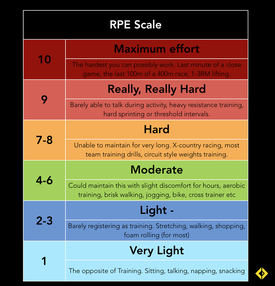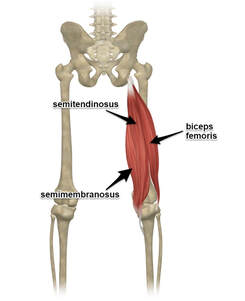|
What is aerobic fitness? Aerobic fitness can be defined as one’s ability to transport and deliver oxygen to the muscles, so it can be utilised to generate energy to support the activity of the muscle during exercise (1) There are three major components to aerobic fitness which can be viewed below (2).
General exercise recommendations for increasing your aerobic fitness 3
Training methods for increasing your aerobic fitness. There are three basic forms of aerobic fitness training: continuous training, interval training and Fartlek training (4). Continuous training Involves continuous exercise such as jogging, swimming, walking, or cycling, at “somewhat hard to hard” intensities without rest intervals. The prescribed exercise intensity is maintained consistently throughout the exercise session. Interval / HIIT training
Fartlek training Fartlek training or “speed play” is similar to interval training, but is a free form of training, which involves interspersing short bursts of intense/faster work throughout a continuous training activity. The exercise-rest cycle is not systematic or precisely timed and measured but is based on the feelings of the participant. The bottom line
Completing some form of aerobic exercise is better than completing no aerobic exercise. If you’re not sure where to start, it is best to start with small increments (5 – 10 mins) of light intensity exercise (walking or cycling) and slowly increase the duration over time. Once you can comfortability tolerant this, look to start increasing the duration. Once you can complete greater bouts of aerobic exercise look to increase the intensity, eventually aiming to reach the recommended guidelines. Bec Dostan
0 Comments
It is commonly believed that hamstring injuries cause the biggest time loss and are one of the biggest detrimental factors to team performance. This is in the elite sport setting but hamstring injuries are also very common in amateur and community sport as well. Hamstring injuries also don't have to be on the sporting field. One of the biggest risk factors for getting a hamstring injury is previous hamstring injury, so prevention is always better than trying to treat a previous hamstring injury. If you have been unfortunate enough to have had a hamstring injury, don't worry there are still things we can do to lower your risk. What are the hamstrings and what is a hamstring injury? The hamstrings are a group of muscles that sit at the back of your thigh. There are three, Bicep Femoris, Semitendinosus and Semimembranosus. All three cross over the hip and knee joints and therefore all three contribute to both hip and knee function. Their two primary roles are to flex or bend the knee and extend the hip. A hamstring injury is when there is a tearing of the hamstring muscle fibres because of an excessive force or stretching is placed upon the muscle fibres. Hamstring strains happen in all different activities but the most common way to injure a hamstring muscle is while running, and more specifically in the end of the swing phase of the running gait. During this phase the hip is going into flexion and the knee is going into extension. The role of the hamstring during this phase is to control these two movements and contract while lengthening, this is called an eccentric contraction and if there is too much force or the muscle is fatigued then a strain or a tear can occur. Acute rehab phase Directly after a hamstring strain it is important to use the acronym PEACE & LOVE (Protect, Elevate, Avoid anti-inflammatories, Compression, Education & Load, Optimism, Vascularisation, Exercise). Read our blog on this topic to learn more. Allowing the hamstring injury to recover by protecting it and not applying unnecessary excessive force initially and then also using movement and appropriate loading early in rehabilitation is the key for the best outcomes. Maintaining some form of exercise is also key, just because you have a hamstring strain does not mean you can't exercise. A great exercise for optimal loading is the Hamstring Isometric Holds, you apply isometric ( contraction with no muscle length change) loading to the muscle which can help with pain management and you can find the optimal load to apply which can be changed as you progress. Below is the hamstring Isometric holds. Try holding for up to 5 times for up to 30s. Getting back to activities Activities like walking and slow running are great exercises for improving the function of your hamstrings early on and should be a focus for hamstring rehabilitation after the initial acute phase. Building up hamstring strength in the gym or at home with exercises is also important to make sure the hamstring builds its capacity back to what it needs to tolerate to avoid another injury. In my personal opinion this step is probably the most skipped and could be a reason for some hamstring re injuries. What not to do Along with any injury rehab there are always things to avoid to get the best outcome and in hamstring injuries this is passive stretching! Passive stretching is forcefully putting the hamstring on stretch and holding this position and if you remember from my explanation above this is effectively putting the hamstring in the same position as how it got injured. Of course we want to maintain the length and function of the hamstring however passively stretching is not going to help this. What to do to maintain function and length of the hamstrings! Let’s let the powers of human function, biomechanics and brain power help us out. With every hamstring contraction there is another muscle on the front of the leg the quadriceps which is lengthening. If the quads activate then the hamstrings lengthen and the brain allows and facilitates this. So for an Exercise that helps with maintaining the function and length of the hamstring while injured try performing active knee extension and flexion either in lying or a seated position. Here shown in the lying position. Try it just gently to begin with. Going from injury to strength. In order to get the best possible outcome for your hamstring recovery it is important that you can progressively load and expose the hamstring to different types of stimulus. Probably the most important action for any hamstring recovery is trying to increase the maximal force that can be applied during an eccentric contraction, just like the mechanism of a hamstring injury. Mid to late stage exercises to perform to get back to activities effectively are shown below. I would also add getting back to high speed running progressively is also very important!
This type of bridge is best done in mid stage rehabilitation to build up the hamstrings tolerance for load. Begin with a double leg and progress to single leg.
* probably best done with a partner holding your legs but here I have used a heavy object on my heels.
The Nordic Hamstring Curls apply force to an eccentric contraction and help build up the strength in this particular movement. These exercises can be progressed and regressed according to how hard they feel, and should be done consistently after you return to your activity to help lower your risk of another injury. Keeping the hamstrings strong is pivotal in keeping you hamstring injury free. Of course this is not a complete guide nor is it a program to follow but it does give you an insight in how you can go from injury to strength. If you would like a personalised injury prevention program or a hamstring rehabilitation program contact the clinic. Izaac Boylan Accredited Exercise Physiologist What are sets? Are they different to a rep? All the exercise definitions you need to know.26/8/2021  Have you ever been in a gym or group class and all these words are being yelled out and you have no idea what they mean or what you are meant to be doing? We are here to help you understand what all those terms mean to help you feel more comfortable when exercising. Here is our guide to all the exercise terminology you need to know:

This is a beginner’s guide to exercise terminology, if there are more terms you would like to know the meaning of, please get in touch at [email protected] we are happy to help! By, Aleisha Michael Accredited Exercise Physiologist.  Most runners believe that in order to be better-performing and faster-running machines, they simply need to run more and hone their craft by following a well-designed running program. But, that's only half true. The other piece of the puzzle comes from a structured resistance-training program. Even if a runner wants to improve their running time at the middle or long distances, strength training is a must to improve. How does strength training help? The main reason is to improve our running economy Running economy basically means that you are more efficient and able to undertake the same distance in less time and with less energy. There are heaps of studies showing improvements in running economy and that even in trained distance runners that running economy can improve by up to 8% following a period of resistance training. So for a serious runner who undertakes marathons, 8% off of a 4 hour marathon is 20 minutes, so a pretty good improvement - even shaving 10 minutes off a marathon would make most runners pretty happy! There is a second train of thought that strength training also decreases our injury risk. However there are inconsistent findings in the literature on associations between lower body strength and running injury occurrence. So the main reason to strength train is to improve our running economy. What does a typical program that a runner should undertake look like?
What are some examples of exercises people can do at home? An example gym program for runners might include exercises like:
Power work is also beneficial to improving running economy:
Check out a few strength training exercises here: Lisa Parkinson Accredited Exercise Physiologist 1. Be prepared
Make sure you have the right gear, which is really just a good supportive pair of footwear and if you're female a good fitting bra. That’s the beauty of running. You don’t actually need fancy workout clothes, a top of the range GPS tracking watch, or a running coach, you just need decent footwear and a desire to get started. 2. Stop procrastinating and just get started You might feel overwhelmed by how to start running – do you need the fancy watch, a program for what you should be doing or anything else, but just getting started and forming a habit of undertaking regular exercise is the first step. On your first run, try and set a time that you are going to be out exercising for - that might be as little as 20 minutes including your warm up and cool down. And don’t expect that you are going to be able to jog for the whole time you are out on your first run. 3. Use the walk run method As it says, this is a training method where you undertake walking and jogging intervals throughout your training session. Following your warm up you might start with jogging for 1 minute, followed by walking for 4 minutes, repeating that cycle for 4 times. As your fitness improves you can slowly increase the amount of time that you jog, and decrease your walking time – so after 4 weeks it might be a cycle of 4 mins jogging, and 1 minute walking. It’s always good to finish with a walking segment to cool down, and then end with stretches. If you have a higher level of base fitness, you might start straight at 3 mins jogging and 2 minute walking or even more. Basically you want to be at about a 6 or 7 out of 10 in terms of challenge or exertion level by the end of your jogging interval. Beginners Program:
Intermediate program:
Some of the mistakes people make are trying to do too much too soon which can lead to injury or burnout. So, when you are starting out don’t try and run too fast, try and stick to a steady cruisy pace that you can maintain for the entire run. When progressing your running program, you need to progress the total time of your runs, or frequency of running each week slowly. If you have worked up to 3 times a week for 20 minutes continuously – you're undertaking 60 minutes of jogging each week. To progress that we want to use the 10% per week rule. Therefore the following week would include 66 minutes in total. Or 3 x 22 minutes. 5. Use tools to keep you inspired Running Journal Keep a running journal, or use an app like map my run which can track your distance, pace, and even talk to you along the way. Run with a friend Find a running partner as it can then become a social catch up as well. Use music Your favourite music played through your phone or ipod can motivate you; or search spotify for a running playlist; or make your own playlist of motivating music. There are also apps which will select songs with the same beats per minute as your running cadence to keep you on track. Podcasts or movies Listening to a favourite podcast, or if your’re on the treadmill catching up on your favourite netflix episodes can help the time pass quickly. Interval training apps There are a number of interval training apps that you can download for free or purchase that you can program your planned work:rest schedule into so that it beeps to let you know when to run/walk. I use seconds pro for my workouts but there are many others in the app store. Lisa Parkinson Accredited Exercise Physiologist. |
AuthorSLisa Parkinson Archives
July 2024
Categories
All
|






 RSS Feed
RSS Feed